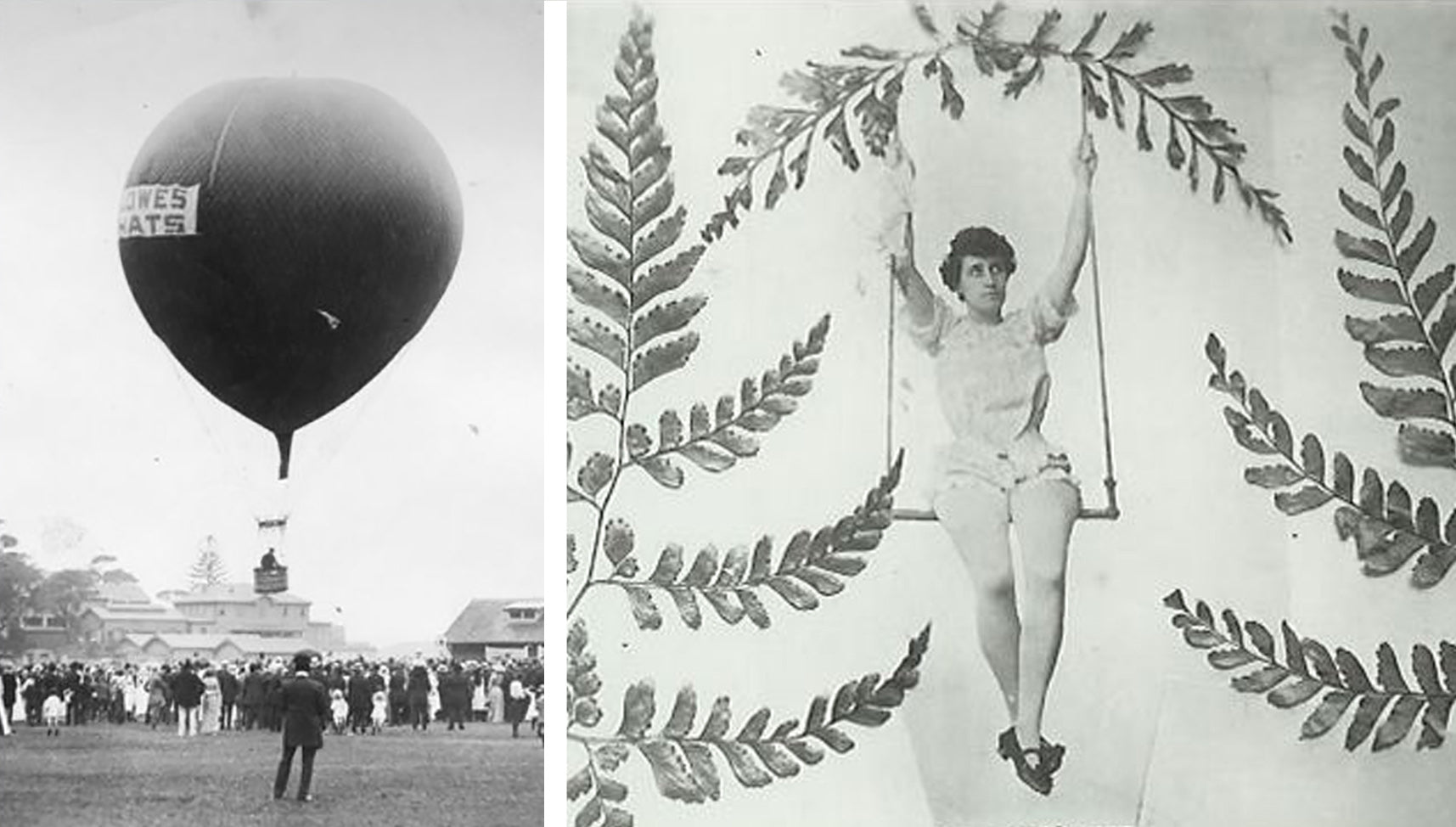The first known ascent of a gas balloon was made in Paris in 1784, and many further attempts followed. After numerous failures, the first successful flight in NSW was made from the Domain, in front of a large crowd, in December 1858. Over the following decades this fascination with flight grew, and though still perilous, many “aeronauts” took up the challenge. Ascents were advertised to take place at shows, the races, pleasure grounds and gatherings for public holidays, crowds flocking to see this wonderful new phenomenon.
By the 1890s Mosman’s population was growing rapidly, and local exhibitions of such novelties drew large crowds of locals and visitors. The pleasure ground at Clifton Gardens was a favourite site for these performances. Such an attraction was advertised for Boxing Day 1894, when a “Maxim Flying Machine” was to be launched, then fly over Chowder Bay. This machine was constructed of steel tubes and wires, with large canvas wings, powered by a boiler for generating steam power. It was positioned at the top of a 40 feet high light railway, which sloped down a cliff to the harbour – the contraption was on a trolley from which it was to be tipped toward the water as the wings lifted it aloft. Needless to say it tipped straight onto the rocks without taking flight at all, the hot boiler setting fire to the rest of the machine, and the crowd booing and jeering. The promoters claimed that onlookers had interfered with the apparatus, and that there was insufficient wind to set the wings in motion. Regardless, it was a complete failure and the Maxim project was abandoned.

Balloon ascents however were usually more successful, and were regularly advertised around Sydney as holiday entertainment. The following Boxing Day, 1895, holidaymakers at Clifton Gardens had a “sensational and thrilling experience of a balloon ascent and parachute descent by Professor J.W. Price, an American aeronaut”. Over a thousand visitors watched the canvas balloon being inflated, and an ascent to a height of almost 8,000 feet was made. The wind carried the balloon towards Mosman Bay where the Professor detached himself from the craft and floated to earth in his parachute, a performance deemed highly successful.
Things didn’t always go so smoothly however. In January 1896 another American, Miss Leila Adair, dressed in black velvet knickerbockers, worked stockings, white bishop lawn blouse and a yellow sash, made an ascent in front of several thousand people. Sitting on a trapeze beneath the balloon, she gracefully rose to a height of over 800 feet then began to drift across the harbour, where she separated her parachute from the balloon. The crowd, thinking the show was over, began to leave, but as she disappeared from sight behind Bradleys Head, disaster struck. Instead of landing on solid ground, a strong wind gust blew her into Taylor Bay. She was rescued, unconscious, by two Italian fishermen. Though she could “swim like a fish”, she said later, her parachute, strapped to her wrist, had dragged her under water and nearly smothered her. She was returned to Clifton Gardens, where she recuperated for several days at Mr Thompson’s Marine Hotel. (Miss Adair had already had serious injuries and several brushes with death while touring New Zealand in 1894).

From 1909 to 1920 aeronaut “Captain Penfold” (Vincent P. Taylor) regularly made balloon ascents at Clifton Gardens and other harbour venues, demonstrating the uses to which balloons could be put. At various times he dropped bombs and other munitions from high altitudes to demonstrate their value for military purposes, fired guns at targets, and detonated explosives electrically from mid air. In 1914 he planned to make an ascent with a passenger – clothing manufacturer William Lowe had volunteered. Unfortunately Lowe’s weight prevented his flight but, undaunted, he attached a large sign advertising Lowes Hats to the balloon. The flight proceeded with just Penfold aboard, and was blown beyond Brookvale where he landed and was lost in the bush for several hours. Later that year “Captain Penfold” flew a balloon from Clifton Gardens to Liverpool, with his sister Miss Chrissie Taylor as passenger taking aerial photos with her Kodak camera along the way.
Captain Penfold takes off at Clifton Gardens in 1914. The long demolished dance pavilion and hotel buildings are in the background.
Source: State Library of South Australia
So popular were these events that Sydney Ferries for years ran extra services from the Quay to Clifton Gardens. However when World War 1 broke out, and aeroplanes became a reality and a more practical form of flight, balloon ascents were no longer such a drawcard. Penfold, who gained fame as a daring aviator and balloonist, went to America in 1920 in search of work, performing parachute and aeroplane stunts, but died penniless in 1930. Balloons as entertainment became a thing of the past.
P. Morris, Mosman Historical Society From newspaper reports of the day on Trove, National Library of Australia, and Papers Past, National Library of New Zealand References available on request.
Photos
Image 1: Maxim Flying Machine preparing to fly at Clifton Gardens. Source: Source is Australian Town and Country Journal, 12 Jan. 1895, p.31. https://trove.nla.gov.au/newspaper/article/71224479?searchTerm=flying%20machine%20maxim&searchLimits=l-illustrated=true|||l-decade=189|||l-year=1895
Image 2: Captain Penfold takes off at Clifton Gardens in 1914. The long demolished dance pavilion and hotel buildings are in the background. Source: State Library of South Australia
Image 3: Miss Leila Adair. Studio recreation of her Palmerston North (NZ) balloon ascent in 1894. Nancy Swarbrick, 'Aerial recreation - Ballooning', Te Ara - the Encyclopedia of New Zealand, http://www.TeAra.govt.nz/en/photograph/6084/american-balloonist-leila-adair
